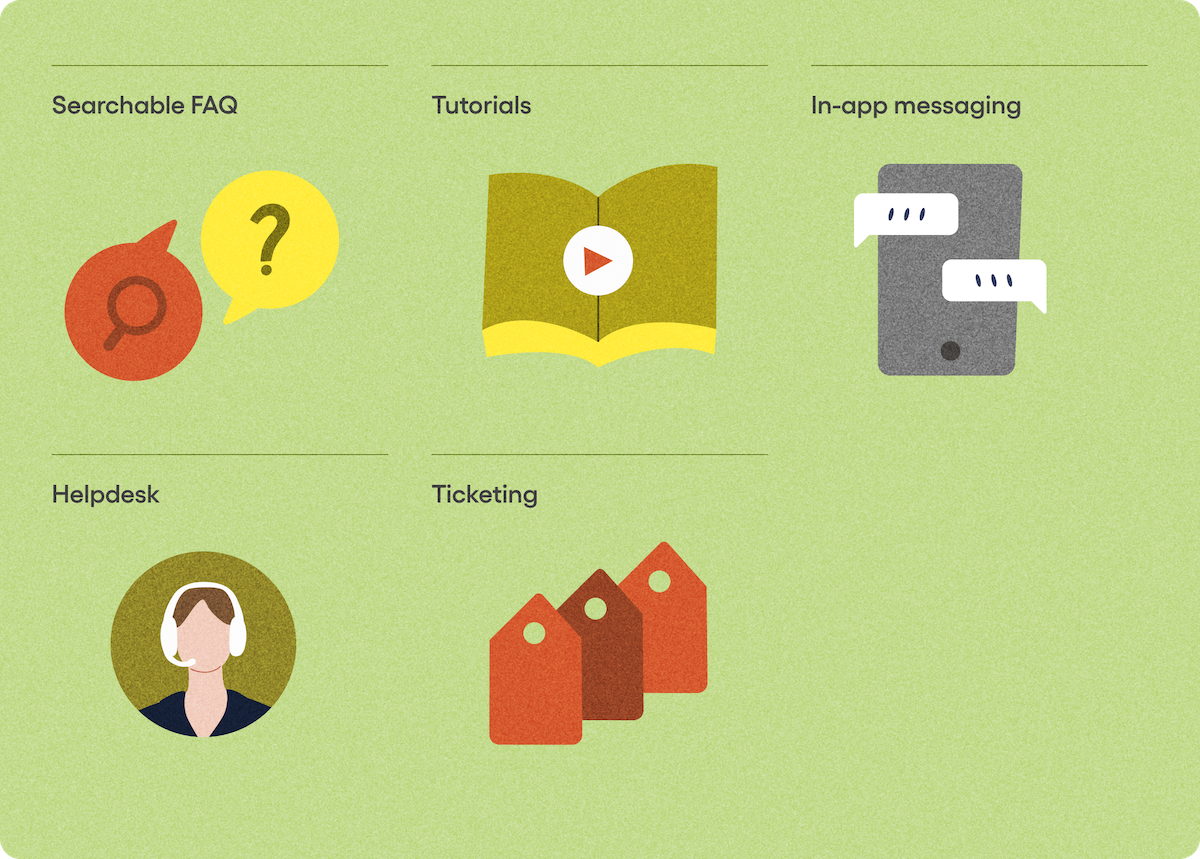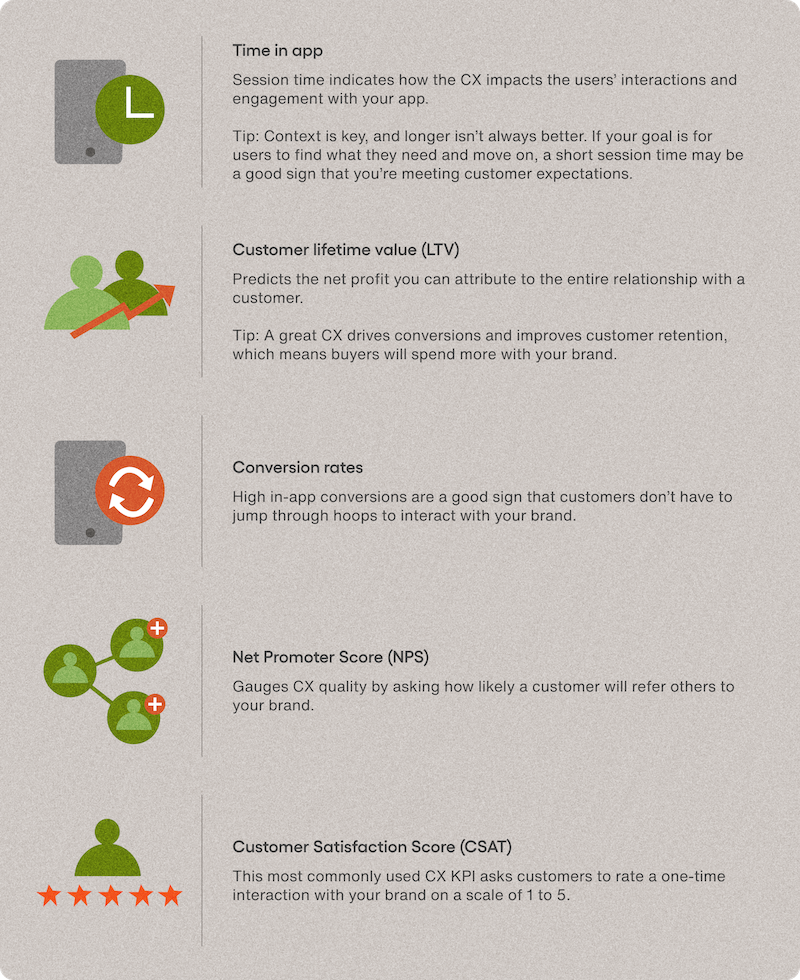Top customer service management strategies for 2024 and beyond

Customer experience (CX) is the name of the game for any brand that wants to stay competitive, and customer service is a critical piece of this puzzle. In a recent survey by Zendesk, 70% of organizations reported a direct connection between customer service and business performance.
But with fast-changing consumer expectations and ever-evolving customer touchpoints, it’s getting more challenging for brands to stay ahead in their customer service management (CSM) strategies. So what’s new for 2023 and beyond?
Let’s look at the latest customer service management strategies, what good customer services look like, and how to implement an in-app strategy to drive sales, reduce churn, and improve customer loyalty.
But first… What’s the difference between customer service and customer experience?
Customer service focuses on answering customers’ questions and helping them solve problems related to your products. It’s typically initiated by a customer and often involves interactions with a customer service agent via a single touchpoint.
Meanwhile, customer experience is about engaging and interacting with prospects and customers at every stage of the customer lifecycle across multiple channels. It takes a proactive approach to delight customers and increase customer loyalty.
The differences between these two concepts are reflected in the metrics used for measuring them. Customer service KPIs focus on how quickly you resolve issues (e.g., Time to Resolution), while customer experience metrics put an emphasis on sentiment (e.g., Net Promoter Score).
Top customer service management strategies for 2023
Gone are the days when consumers were willing to listen to call centers’ hold music for 20 minutes or wait 48 hours for an email reply.
A modern customer service management strategy must deliver personalized, contextual, real-time support to consumers when and where they need it. Brands must go beyond the same old channels to embrace new customer behaviors and preferences. Here’s how:

In-app customer service
As more people consume content, make purchases, and interact with brands via mobile apps, you must provide high-quality customer support via this channel.
Give users multiple ways to access support via your mobile app. These include a searchable FAQ section, tutorials, in-app messaging, and a helpdesk and ticketing system. You can also automate responses to handle widespread customer issues such as interrupted services and scheduled maintenance.
Personalized live chat
Live chat has the highest customer satisfaction levels—73% of consumers prefer to use this channel compared with 61% for email and 44% for phone.
Offer real-person, real-time support to answer customer requests and inquiries while delivering a contextual and personalized experience. You can also enrich the chat experience with voice or video calls and screen sharing to improve communication, reduce frustration, and shorten the time to resolution.

Virgin Mobile UAE improved their CSAT with Sendbird Desk.
Customer self-service
81% of consumers look for answers on their own before reaching out to customer service. Meanwhile, 77% of people said they had used a customer self-service portal.
Customer self-service capabilities help you lower support costs while improving customer satisfaction. Update your knowledge base regularly and ensure that it addresses common issues. Use AI virtual assistant and chatbot technologies to direct users to the appropriate resources or escalate the inquiry to a live agent.
Community Q&A
An in-app community with active and knowledgeable users is a great place where customers can ask questions and get answers without waiting for your support team members to respond.
Besides encouraging users to participate in the community, implement a content moderation strategy to ensure that the responses follow your company’s guidelines. Also, include robust search functionalities so customers can find their answers from previous discussions to streamline the experience.
An emphasis on customer experience
Users will require less support if you share content along the customer journey that proactively addresses potential issues before they become a problem.
Invest in the entire customer lifecycle, and don’t stop after a buyer has made a purchase. Consider the post-sales experience as well—this is where the magic happens! When you preempt customers’ questions (e.g., send onboarding emails with tips to use the product), you can help users get more value from your products while reducing support costs.
Checklist: Is your app delivering a great customer experience?
Use these KPIs to see if your mobile app is delivering an outstanding CX:

What a winning customer service experience looks like
In today’s instant gratification consumer culture, you need a fast response time–but that’s not all. You must resolve issues quickly as well. It’s no surprise that 66% of consumers appreciate brands that value their time through efficient workflows that deliver prompt customer service.
Personalization is another hallmark of stellar customer service. Besides referring to customer data, such as profile information and purchase history, customer service representatives should address the context in which a user makes their decisions. For example, reference the content or user flow that causes a customer initiates a live chat or in-app message.
Additionally, you must provide omnichannel support via phone, email, social media, in-app messaging, and live chat. These conversations should sync with customer profiles in real-time so users can pick up where they left off if a different channel is required to complete the request (e.g., switching from phone to video chat to help with troubleshooting).
Collect customer feedback to make targeted improvements to your CX. Besides surveys and interviews, you can analyze records of support conversations to see what customers want and gauge their sentiments. The insights can help you personalize the support experience and find new opportunities to improve.
Ultimately, the goal of customer support is to resolve issues as quickly as possible to increase customer satisfaction and support customer success. As such, you should empower your customer service team to find creative ways to devise the best solutions.
Implementing in-app customer service management strategies
Delivering outstanding customer service via your mobile app helps customers communicate with your business on their own time. Offering highly personalized, in-context customer interactions via in-app messaging builds loyal customers.
But implementing these features from scratch is often a lengthy and labor-intensive process. The good news is that you don’t have to reinvent the wheel.
Sendbird’s SDK allows you to offer a fully customized and integrated in-app support experience to meet your customers’ needs. Besides all the messaging features today’s consumers expect, you can easily integrate Sendbird with your existing customer relationship management (CRM) system or contact center solution to deliver a seamless, omnichannel customer experience.
Try Sendbird for free and see how we can help you augment your customer support for a better CX.










